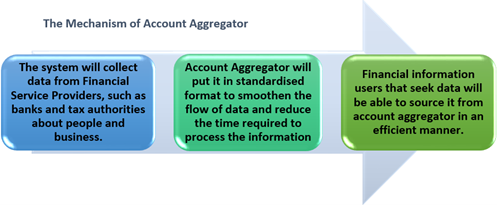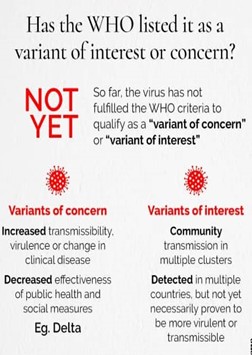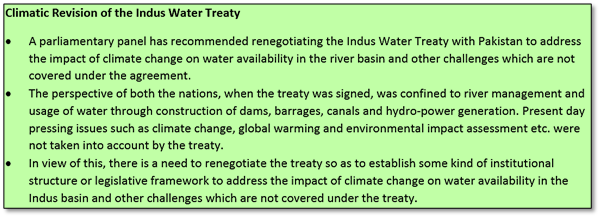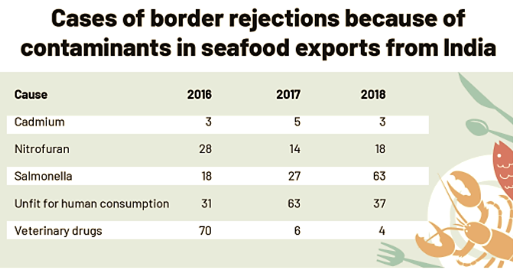Friday, 3rd September 2021
User-data system in Finance
In News
India has unveiled a data sharing system which would enable people to have greater access and control over their financial records.
About the Account Aggregator
- The data sharing system is basically an account aggregator which would combine privacy protection with credit reporting.
- As per RBI “Account Aggregator” means a non-banking financial company that undertakes the business of an account aggregator, for a fee or otherwise.
- The system lets users pull together all kinds of financial data -- starting with bank statements but eventually even mobile bill payments, tax filings and retirement fund balances -- that they can then choose to share instantly and temporarily in pursuit of loans, investment products or even insurance.
Benefits of the system
- The Account Aggregator model will help in the democratization of data and shift the power over data accessibility and usage to owners of data rather than the holders of data.
- The Account Aggregator system could bridge the data gap, making nearly 90% of businesses eligible to seek digital credit and enable faster assessment of credit worthiness.
- ndia aims to open finance to millions with user-data system: Thus, it will enable millions of underprivileged individuals and small businesses to access loans who are usually denied because of lack of collateral.
- It will enable financial service provider to customise a wealth management product for an individual, or tailor an insurance policy for a family.

- The AA system is the starting point for consent architecture that starts with financial services but can be equally applied to health-care data and jobs data.
Source:
Birds of prey threatened: IUCN
In News
An analysis of data has found that raptor species worldwide are near threatened, vulnerable or endangered or critically endangered.
About the News
- A new analysis of data from the International Union for the Conservation of Nature and BirdLife International has revealed that 30% of 557 raptor species worldwide are considered near threatened, vulnerable or endangered or critically endangered.
- Eighteen species are critically endangered, including the Philippine eagle, the hooded vulture and the Annobon scops owl, the researchers found.
- Of threatened birds of prey that are active mostly during the day — including most hawks, eagles and vultures — 54% were falling in population
Reasons behind such a systematic threat?
- Habitat loss: The population of Philippine eagles and Harpy eagles in Central and South America has decreased rapidly in the last decades due to extensive deforestation.
- Climate Change: Climate change works in concert with other factors to change habitats and ultimately reduce prey populations.
- Toxic substances: Widespread use of diclofenac (a non-steroidal anti-inflammatory drug used to treat cattle) in Asia (including India), insecticide like DDT, pesticide, lead etc has eventually poisoned food of vulture like cattle carcasses and rodents.
- Shooting: Shooting these birds (for food, recreation, alleged medicinal utility) has also led to their sharp decline in African countries.
Why should we be concerned?
- Food security: Raptors (Birds of Prey) prey on a wide range of vertebrates and thus, facilitate long-distance seed dispersal. This indirectly increases seed production and pest control.
- Population balance: Raptors (Birds of Prey) also play an important ecological role by controlling populations of rodents and other small mammals.
Vultures Status in India

Source:
C.1.2 Covid-19 variant
In News
The National Institute for Communicable Diseases in South Africa has recently issued an alert about the C.1.2 Covid-19 variant.
What is C.1.2 and what is unique about the variant?
- Reason for Concern:1.2 is a variant of Covid-19 virus which has been mutating at a rapid pace and is found to be extremely potent in evading the protection offered by antibodies.
- First Detected: It was first detected in Africa and has now spread to the majority of the provinces in South Africa and in seven other countries spanning Africa, Europe, Asia and Oceania.
- WHO Criteria: So far, the virus has not fulfilled the WHO criteria to qualify as a ‘variant of concern’ or ‘variant of interest’.

Key mutations carried by C.1.2
- In addition to the mutations that were already seen in the C.1 variant, C.1.2 carries some additional mutations within the spike proteins.
- 1.2 contains many mutations that have been identified in all four variant of concern (VOCs)-Alpha, Beta, Delta and Gamma and three variant of interest (VOIs) - Kappa, Eta and Lambda.

Source:
- Explained: What is the C.1.2 variant of Covid-19, and will vaccines work against it?
- C.1.2 Covid-19 variant: Centre says no cases in India so far, but how deadly is it?
- New Covid-19 variant C.1.2: No cases in India so far, says govt
- C.1.2 COVID-19 variant | A look at what we know so far about the newly discovered mutation
- C.1.2: All you need to know about the new ‘highly transmissible’ Covid variant
Image Source:
Ladakh adopts State Animal and Bird
- Context: Ladakh has adopted snow leopard and black-necked crane, as State animal and State bird respectively.
- Black-necked cranes (Grus nicricollis), considered loyal couples, are only found in Ladakh’s Changthang region.
- It is listed in Schedule I of Wildlife (Protection) Act 1972 and as Endangered on the IUCN Red List.
- Snow leopard (Panther unica) are solitary and elusive creatures inhabiting high altitude mountainous regions of China, Bhutan, Nepal, India, Pakistan, Afghanistan, Russia, and Mongolia.
- They are both top predator and an indicator of the health of their ecosystem.
- Their numbers are dwindling wordwide and they are categorized as “vulnerable” in the International Union for Conservation of Nature Red List

Source:
Picture source:
The Indus Water Treaty
In News
Pakistan has raised objections to the design of India’s Kiru hydroelectric plant, a mega 624 MW project over Chenab River in Jammu and Kashmir.
About the News
- Kiru Hydro Electric Project (624 MW) is proposed on River Chenab, located in Kishtwar district of the Jammu & Kashmir. The project is envisaged as a Run of River Scheme.
- In response to Pakistan’s objections, India has asserted that the design of the project is fully compliant with the provisions of the Indus Waters Treaty (IWT).
- As per India, as a responsible upper riparian state, India is committed to full utilisation of its rights and believes in an amicable resolution the issues raised by Pakistan side in letter and spirit of the treaty.
- The IWT gives the right to Pakistan to raise objections to designs of Indian hydroelectric projects on the western rivers.

What is the Indus Water Treaty?
- Objective: About 60 years ago, on September 19, 1960 (effective from1st April, 1960), the Indus Waters Treaty (IWT) was signed between India and Pakistan to share waters from the Indus rivers system (IRS), to resolve the dispute between two countries regarding the utilization of irrigation water from existing facilities.
- The Indus rivers system (IRS) comprises of main stem of Indus river along with its five left bank tributaries, namely, the Ravi, the Beas, the Sutlej , the Jhelum and the Chenab and a right bank tributary, namely, the Kabul which does not flow through India.
- Water division: Under the IWT, the waters of the eastern rivers, Sutlej, Beas, and Ravi, amounting to around 33 MAF annually is allocated to India for unrestricted use.
- The waters of western rivers — Indus, Jhelum, and Chenab — amounting to around 135 MAF annually has been assigned largely to Pakistan.
- Exit Clause: The IWT does not have a unilateral exit clause. Technically, under the Vienna Convention on the Law of Treaties, there are provisions to sever and withdraw from the treaty.
However, the provisions cannot be appropriately used to abrogate the IWT.
- Even the severance of diplomatic and consular relationships between India and Pakistan cannot terminate the IWT.
The Significance of IWT for India
- Water Supply: The IRS is an important source of water supply for Indian states in various capacities like irrigation, drinking water etc. Thus, India is working on exercising its rights to stop excess water flowing to Pakistan under the Indus Waters Treaty of 1960 to irrigate its own lands.
- Hydro-power projects: According to the treaty, India has been given the right to generate hydroelectricity through the run of the river (RoR) projects on the western rivers which, subject to specific criteria for design and operation.
- As per the Indus Waters Treaty, whoever builds the project first will have the first rights on the river waters.
- Strategic importance: India’s plans to fully utilize its share of water under the treaty assumes strategic importance against the backdrop of China developing the controversial China-Pakistan Economic Corridor in the region.
- The strategic importance arises from the control over river water flow, which acts as a force multiplier during times of aggression.
- Territorial Sovereignty: With an eye on Pakistan, India is also expediting other strategically important hydropower projects in Jammu and Kashmir such as 850-megawatt (MW) Ratle, 800MW Bursar, 1,000MW Pakal Dul, 624MW Kiru and 540MW Kwar in the Union territory following the reorganization of the terror-hit state.
- There has been growing collaboration between Pakistan and China on security, economy and water projects, primarily on the western flowing rivers of IRS.
- Bilateral Relation: As a document, the treaty may have certain weaknesses, but the larger problem is the fraught relationship between India and Pakistan.
How is India utilising the waters of Eastern rivers?
- The treaty clearly spells the do's and don'ts for both countries; as it allows India to use only 20 per cent of the total water carried by the Indus river.
- To utilise the waters of the Eastern rivers which have been allocated to India for exclusive use, India has constructed the Bhakra Dam on Satluj, Pong and Pandoh Dam on Beas and Thein (Ranjitsagar) on Ravi.
- These storage works, together with other works like Beas-Sutlej Link, Madhopur-Beas Link, and Indira Gandhi Nahar Project have helped India utilise nearly the entire share (95 per cent) of the eastern river waters.
- About two MAF of water annually from Ravi is reported to be still flowing unutilised to Pakistan. To stop the flow of these waters, the Centre is currently taking three steps to utilize its entire share of waters given under the Indus Waters Treaty 1960:
- Resumption of Construction of Shahpurkandi project: This project will help utilize the waters from the Thein dam to irrigate land in J&K and Punjab and generate 206 MW of power.
- Construction of Ujh multipurpose project: This project will create a storage of about 781 million cu m of water on river Ujh, a tributary of Ravi for irrigation and power generation.
- The 2nd Ravi Beas link below Ujh: This project is being planned to tap excess water flowing down to Pakistan through river Ravi, by constructing a barrage across river Ravi for diverting water through a tunnel link to Beas basin.
What have been the challenges to the IWT over years?
- The growing number of multipurpose hydropower projects on the IRS rivers to effectively manage the available waters and generate electricity has become a cause for tension, as both India and Pakistan contest each other projects.
- The issue of the Salal dam emerged in 1970 and was resolved by the two countries in 1978
- The second one was over Baglihar dam which they settled in 2007 with the help of World Bank appointed Neutral Expert Professor Raymond Lafitte.
- The dispute over Kishanganga Hydro Electricity Project (KHEP) was taken to the matter to the Permanent Court of Arbitration which delivered its final verdict in 2013 in India’s favour.
- Pakistan had also raised objections on the 850 MW Ratle, 1,000MW Pakal Dul and 48MW Lower Kalnai hydroelectric projects on River Chenab.
- Border Issues: In the wake of the Uri attack in 2016, Delhi suspended the bi-annual talks and promised to ‘fast-track’ projects to use hitherto unutilised water of the eastern rivers allocated to India via three national projects.
- Pakistan’s project: Pakistan’s Left Bank Outfall Drain (LBOD) project across the Rann of Kutch in Gujarat, was objected by India as this is in contravention to the IWT. As the lower riparian state is in India, hence the details of the project need to be shared with India.

Conclusion: The treaty is often cited as an example of the possibilities of peaceful coexistence that exist despite the troubled relationship. It is also dubbed as “uninterrupted and uninterruptible”. To continue with such a status, the clamour of India abrogating the IWT as a response to Pakistan’s cross-border terrorism and intransigence needs to be taken care of. The factors like politico-diplomatic and hydrological factors, along with political consensus need to be considered.
Question: Discuss the Indus water treaty with its significance for India. Elaborate on the projects undertaken by India on the basis of IWT.
Sources:
- Pakistan objects Kiru hydro plant design, India says project compliant with Indus Waters Treaty
- Parliament panel recommends renegotiating Indus Waters Treaty to address climate crisis impact:
- India to divert excess waters under Indus treaty to irrigate own land:
- Sixty Years of the Indus Waters Treaty and How It Survived Many a Fraught Moment
- Indus Waters Treaty: All about the water distribution pact between India and Pakistan
- Indus Waters Treaty 1960 : Present Status of Development in India:
- INDUS WATERS TREATY 1960
- INDUS WATERS TREATY 1960
- Indus Water Treaty at 60: why there is a need to give it a fresh look
Viking 2
On September 3, 1976 after a nearly year-long journey, NASA's robotic spacecraft Viking 2 landed on Mars and began relaying information about the planet's atmosphere and soil as well as colour photographs of the rocky surface. Viking 2 landed on Mars immediately following the first successful spacecraft landing on Mars by Viking 1 and was part of NASA's early two-part mission to investigate the Red Planet and search for signs of life.

Source:
Indore
This is the image of Indore, the country's cleanest city, which has now been declared as the first 'water plus' city of India under the Swachh Survekshan 2021. According to the criteria, dirty water should not drain into any river or drain. Also, 30 per cent of the city's sewer water has to be recycled and reused. Public toilets must be connected to sewer lines and must be cleaned. Indore carried out survey & halted 7,000 outfalls of grey water that went in rivers, drains.

Source:
UNSC Resolution 2593 on Taliban
- Context: Resolution 2593 has been recently adopted by the United Nations Security Council under India’s presidency.
- The resolution stated that the territory of Afghanistan is not to be used to threaten any country or shelter terrorists, and that the international community expects Taliban to adhere to the commitments they made regarding the safe and orderly departure of Afghans and all foreign nationals from the country.
- The resolution was sponsored by France, UK and the US and was adopted with 13 members, including India, voting in favour and none against it. However, the permanent and veto-wielding members Russia and China had abstained from voting.
- The resolution stressed the importance of maintaining humanitarian access, upholding human rights, reaching an inclusive political settlement and combating terrorism.
- It however did not spell out any provision to punish the Taliban if they failed to allow such departures or follow the commitments.

Source:
- Adopting Resolution 2593 (2021), Security Council Condemns Deadly Attacks in Afghanistan, Calls for Combating Terrorism, Upholding Human Rights
- India in chair, UNSC adopts resolution on Taliban; Russia and China abstain
Image Source:
Poshan 2.0
- Context: Union Minister for Women and Child Development has launched Poshan 2.0, urging all aspirational districts to establish a Poshan Vatika (nutrition garden).
- Mission Poshan 2.0 (Saksham Anganwadi and Poshan 2.0) is an integrated nutrition support programme that was announced in the 2021-22 budget, merging the Supplementary Nutrition Programme (SNP) and the Poshan Abhiyaan.
- It aims to strengthen nutritional content, its delivery, outreach, and outcomes with focus on developing practices that nurture health, wellness and immunity to disease and malnutrition.
- It is an umbrella scheme that brings together the Integrated Child Development Services (ICDS)-Anganwadi Services, Supplementary Nutrition Programme, Poshan Abhiyaan, Scheme for Adolescent Girls and National Crèche Scheme.
- Implementation of this mission will be done by the Ministry of Women and Child Development in collaboration with the Ministry of Health and Family Welfare and the Ministry of Education under the aegis of Early Childhood Care and Education (ECCE) within the National Education Policy (NEP).

Source:
- Budget 2021: Mission Poshan 2.0 launched to achieve universal nutrition
- MISSION POSHAN 2.0 - NURTURING THE FUTURE OF INDIA
- Thematic’ POSHAN Maah to Be Celebrated Across the Nation throughout the Month of September as Part Of Azadi Ka Amrit Mahotsav
Picture Image :
ZAPAD 2021
- Context: The Indian Army contingent will be participating in 'ZAPAD 2021' at Nizhny in Russia.
- ZAPAD 2021 is a 13-day multi-nation military exercise that is aimed at boosting anti-terror cooperation.
- It is one of the theatre level exercises of Russian armed forces that aims to enhance military and strategic ties amongst the participating nations.
- More than a dozen countries from Eurasia and South Asia including the Indian Army will be participating in the exercise.
- China and Pakistan are also expected to take part in the exercise as observers.

Source:
- Indian Army to participate in multi-nation military exercise 'ZAPAD 2021' in Russia
- Indian Army contingent of 200 to participate in multi-nation military exercise in Russia
Image Source:
Reshaping the State-citizen relationship
Essence: The article talks about the need to reshape the State – Citizen relationship from the present legalistic and compliance-based culture to a participative one.
The present bureaucratic norms are shaped by legalistic norms where hierarchy is deployed to exercise power. These norms privilege compliance, rule-following and legitimizes demands for public discipline to achieve policy goals. There are innumerable cases of high-handedness of police during lockdown, “verification” of beneficiary of govt. schemes and seeing public with suspicion. There is a need to shift towards deliberative/democratic norms which promotes a culture of dialogue and collective problem solving where bureaucracy engages the public. This will help in reducing the distance between the bureaucracy and the public.
Why Should you read this article?
- To know about the present concerns about the state- citizen relationship.
- To understand how the present bureaucratic culture needs to shift from legalistic norms to deliberative norms
Source:
Net zero emission can’t halt climate change
Essence: The article highlights at increase in occurrence of natural disasters resulting in health issues, lack of food security, compromised quality of life among others. The quantum of migration due to climate change is 100 times more than displacements due to conflicts. India has raised the issue of climate justice as the climate burden she carries is four times her climate guilt. The upcoming COP26 should focus on providing financial and technical support to developing and emerging economies as promised by the developed world.
Targeting ‘Net-Zero’ Emissions alone would be insufficient, rather the world should aim for zero emissions from agriculture, deforestation, dirty supply chains, etc. Deforestation adds 12 per cent of carbon emission while a forest fire contributes upto 25 per cent. For carbon negative environment and nature positive society, rapid prototyping of nature-based solutions and encouraging green finance shall nudge the world in the right direction.
Why you should read this article?
- It talks about the different issues arising due to climate change.
- To understand Climate Justice and the methods to mitigate climate change
Net zero emission can’t halt climate change
Mobile Mohalla Clinic
Background
- Mohalla clinic is one of the flagship initiatives of the Delhi government to boost the primary healthcare system in Delhi.
- However, acquiring land for the clinics was a significant roadblock. Therefore, only 500 such clinics have been developed since 2015.
New initiative
- Two Mohalla clinics were constructed inside portable shipping containers.
- This makes them easier to install than constructing a new clinic in a given space such as a congested residential area.
- The new structures can be set up quicker than permanent structures and they will also occupy less space and are designed to maximize the use of the space.
Benefits
- Ideal in Congested areas:Helps in reducing the need for land space. A mohalla clinic would be made in an area of 600 square feet but these shipping containers occupy 320 square feet.
- Accessible:Considering that these containers-based clinics can be mobile, they help in increasing the accessibility of primary health care centers to as many people as possible.
- Strengthen overall Health Infrastructure:Such kind of innovative ideas can be replicated across the country to increase the health infrastructure in India.
Where to Use?
- GS Paper 2 – Issues related to Health Infrastructure
- GS Paper 1 – Urbanization
Why Delhi Govt is Building Mohalla Clinics From Shipping Containers
Share the article
Get Latest Updates on Offers, Event dates, and free Mentorship sessions.

Get in touch with our Expert Academic Counsellors 👋
FAQs
UPSC Daily Current Affairs focuses on learning current events on a daily basis. An aspirant needs to study regular and updated information about current events, news, and relevant topics that are important for UPSC aspirants. It covers national and international affairs, government policies, socio-economic issues, science and technology advancements, and more.
UPSC Daily Current Affairs provides aspirants with a concise and comprehensive overview of the latest happenings and developments across various fields. It helps aspirants stay updated with current affairs and provides them with valuable insights and analysis, which are essential for answering questions in the UPSC examinations. It enhances their knowledge, analytical skills, and ability to connect current affairs with the UPSC syllabus.
UPSC Daily Current Affairs covers a wide range of topics, including politics, economics, science and technology, environment, social issues, governance, international relations, and more. It offers news summaries, in-depth analyses, editorials, opinion pieces, and relevant study materials. It also provides practice questions and quizzes to help aspirants test their understanding of current affairs.
Edukemy's UPSC Daily Current Affairs can be accessed through:
- UPSC Daily Current Affairs can be accessed through Current Affairs tab at the top of the Main Page of Edukemy.
- Edukemy Mobile app: The Daily Current Affairs can also be access through Edukemy Mobile App.
- Social media: Follow Edukemy’s official social media accounts or pages that provide UPSC Daily Current Affairs updates, including Facebook, Twitter, or Telegram channels.





